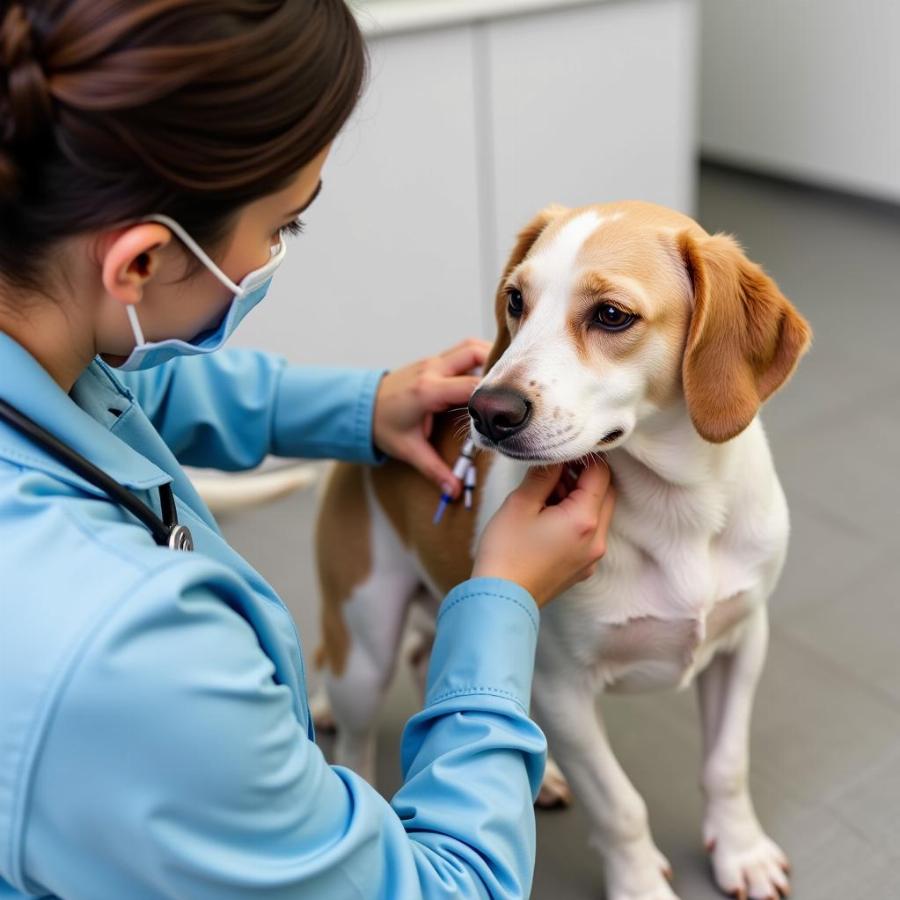If your dog has allergies to grass, you’re not alone. Grass allergies are a common issue for many dogs, leading to uncomfortable itching, redness, and even secondary infections. This comprehensive guide will delve into the causes, symptoms, diagnosis, and treatment options for grass allergies in dogs, helping you understand how to manage this condition and keep your furry friend comfortable.
Understanding Grass Allergies in Dogs
Grass allergies in dogs, also known as grass dermatitis or atopy, occur when a dog’s immune system overreacts to proteins found in grass pollen or the grass itself. Just like humans, dogs can develop sensitivities to various environmental allergens, and grass is often a culprit. This reaction can manifest in various ways, affecting your dog’s skin, ears, and paws. Knowing the signs and symptoms is the first step towards managing this common allergy.
Identifying the Symptoms: Does Your Dog Have a Grass Allergy?
Recognizing the signs of a grass allergy is crucial for early intervention. Common symptoms include excessive itching, licking, and chewing, particularly on the paws, belly, and face. You might also notice red, inflamed skin, hair loss, and even secondary skin infections due to constant scratching. Some dogs may also experience respiratory symptoms like sneezing and coughing, though this is less common with grass allergies. If you notice any of these symptoms, particularly during the grass-growing season, it’s essential to consult your veterinarian.
Diagnosing Grass Allergies: What to Expect at the Vet
Diagnosing a grass allergy involves a combination of physical examination and allergy testing. Your veterinarian will assess your dog’s symptoms, medical history, and conduct a thorough physical exam. Allergy testing, typically through skin or blood tests, can pinpoint the specific allergens triggering your dog’s reaction. This helps confirm the diagnosis and rule out other potential causes of the symptoms.
How is a Grass Allergy Diagnosed?
Your vet will likely ask about your dog’s history of itching and when it’s most severe. They might also perform intradermal skin testing, where small amounts of allergens are injected under the skin to observe for reactions. Alternatively, a blood test can measure the presence of antibodies to specific allergens.
 Xét nghiệm dị ứng chó
Xét nghiệm dị ứng chó
Treatment and Management: Providing Relief for Your Dog
Managing grass allergies involves a multi-pronged approach. Medications, such as antihistamines, corticosteroids, and immunomodulators, can help control itching and inflammation. Topical treatments like shampoos and sprays can soothe irritated skin and provide relief. Lifestyle changes, such as limiting exposure to grass, wiping paws after walks, and regular bathing, can also significantly reduce symptoms.
Long-Term Strategies for Dealing with Grass Allergies
While there’s no cure for grass allergies, effective management can significantly improve your dog’s quality of life. Regular veterinary checkups, consistent medication, and environmental control are essential for long-term management. Consider hypoallergenic diets, omega-3 fatty acid supplements, and immunotherapy to further support your dog’s immune system and reduce allergic reactions. synthetic grass and dogs can be a helpful resource if you’re considering switching to a synthetic lawn.
Is There a Way to Prevent Grass Allergies in Dogs?
Unfortunately, preventing grass allergies entirely is challenging. However, early intervention and proper management can minimize the severity of symptoms and prevent secondary infections. If you suspect your dog has a grass allergy, consult your veterinarian promptly to develop a tailored management plan.
Conclusion
Dealing with dog has allergies to grass can be frustrating, but with proper diagnosis and management, you can help your furry companion live a comfortable and happy life. Remember to consult your veterinarian for personalized advice and treatment options. By understanding the causes, symptoms, and management strategies, you can effectively address this common allergy and ensure your dog’s well-being. allergic reaction to grass in dogs offers further information on the topic.
FAQ
- What are the most common signs of a grass allergy in dogs? Excessive itching, licking, and chewing, especially on the paws, belly, and face, are common indicators.
- Can grass allergies be cured in dogs? While there’s no cure, effective management can significantly reduce symptoms.
- What are the treatment options for grass allergies in dogs? Medications, topical treatments, and lifestyle changes can help manage the condition.
- How is a grass allergy diagnosed in dogs? A combination of physical examination and allergy testing is used to diagnose grass allergies.
- Are there any home remedies for grass allergies in dogs? While some home remedies may offer temporary relief, it’s crucial to consult your vet for appropriate treatment. best anti itch shampoo for dogs provides some helpful recommendations.
- Can diet affect grass allergies in dogs? Yes, a hypoallergenic diet and omega-3 supplements can support the immune system and reduce allergic reactions.
- What can I do to minimize my dog’s exposure to grass? Wipe your dog’s paws after walks, bathe regularly, and consider creating a grass-free area in your yard. anti pee spray for dogs may be useful for discouraging your dog from grassy areas.
Beaut Dogs is your trusted source for comprehensive information on dog breeds, care, and well-being. For personalized advice and support regarding your dog’s health, please contact us at Email: [email protected]. Beaut Dogs is committed to providing accurate and helpful information to help you navigate the wonderful world of dog ownership. Visit https://beautdogs.com today!